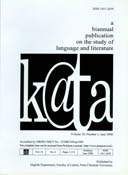Racism in Roald Dahl’s The BFG: A Social Criticism or White Supremacy Tendency?
Abstract
Children stories can be a powerful tool for a writer to present their views of the world around them, both positive or negative ones. This article attempts to examine the message beneath a children novel, The BFG by Roald Dahl by employing Barthes’ five systems of codes. Focusing on the writerly codes, this descriptive qualitative research emphasizes on analyzing the smallest units of the stories, or the lexias. Each lexia is categorized into the three writerly codes to reveal the underlying message in the story. The findings show that despite The BFG being a children book, it consists of some serious social issues like racism. Another thing found in the research is that the issue can lead to a double meaning—whether Dahl intends to raise social awareness or that he wants to subtly say that he himself thinks of other races as inferior.
Downloads
References
Barry, P. (2002). Beginning theory: An introduction to literary and cultural theory. Manchester: Manchester University Press.
Barthes, R. (1974). S/Z. (R. Miller, Trans.). United Kingdom: Blackwell Publishing Ltd. (Original work published 1970)
Bivens, D. (2005). What is internalized racism?. In Potapchuk, M., Leiderman, S., Bivens, D., & Major B. (Eds.) Flipping the Script: White Privilege and Community Building (pp. 43-52). United States: MP Associates, Inc. and Center for Assessment and Policy Development
Bordalo, P., Coffman, K., Gennaioli, N., & Shleifer. A. (2005) Stereotypes. Retrieved from https://scholar.harvard.edu/files/shleifer/files/stereotypes_june_6.pdf
Brice, A. (2012). Young and impressionable: The effect of domestic violence on children. Retrieved from https://www.kcaw.org/2012/11/23/young-impressionable-the-effect-of-domestic-violence-on-children/
Carnevale, A. (2011). Angry Man. Retrieved from http://thisrecording.com/today/2011/6/1/in-which-we-consider-the-macabre-unpleasantness-of-roald-dah.html.
Ciptaningrum, H., & Chotib, M. N. (2013). The portrait of masculinity in Roald Dahl’s The BFG. Jurnal Online Universitas Negeri Malang, 3(1), pp. 1-11.
Diène, D. (2003). Eliminating racism in a changing world: arguments for a new strategy. Dimension of racism. Proceedings of a Workshop to commemorate the end of the United Nations Third Decade to Combat Racism and Racial Discrimination. (pp. 19-20). Paris.
Eccles, J. S. (1999). The development of children ages 6 to 14. The Future of Children WHEN SCHOOL IS OUT , 9(2), pp. 30-44.
Feagin, J. R. (1999). Excluding blacks and others from housing: The foundation of white racism. Cityscape: A Journal of Policy Development and Research, 4(3), pp 79-91.
Felluga, D. (n.d.). Modules on Barthes II: On the five codes. Retrieved from http://www.cla.purdue.edu/english/theory/narratology/modules/barthescodes.html
Flood, A. (2009). Roald Dahl characters still dominate children's favourites. Retrieved from https://www.theguardian.com/books/2009/oct/20/roald-dahl-childrens-favourites
Jaber, M. H. (2016). Female avenger: Violence, absurdity, and black humour in Roald Dahl’s short stories. Journal of college education for women, 27(3), 1170-1183.
Kennerly, H. (2009). Overcoming anxiety. London: Robinson.
Kerridge, J. (2018). The dark truth about Roald Dahl: How anti-Semitism tainted his work. Retrieved from https://www.telegraph.co.uk/books/what-to-read/dark-truth-roald-dahl-antisemitism-tainted-work/
Klugová, J. (2007). Roald Dahl: The author for two audiences: A comparison of his writings for children and adults (Unpublished thesis). University of Pardubice.
Malik, H. W., Zaib, S., & Bughio, F. A. (2014). Theory into practice: Application of Roland Barthes' five codes on Bina Shah's ' The Optimist '. Academic Research International, 5(5), pp. 242-250
May, J. P. (1997). The Journal of the Midwest Modern Language Association,30(1), pp. 81-96.
Morrisey, P. ( 2014). 10 lessons from Roald Dahl books that prepared us for adulthood. Retrieved from https://www.elitedaily.com/life/culture/10-life-lessons-roald-dahl-books-taught-us/763035
Muguro, H. N. (2018) The theme of integrity in children’s literature: An analysis of select children’s books (Master’s thesis). Universtiy of Nairobi. Retrieved from http://erepository.uonbi.ac.ke/bitstream/handle/11295/105498/Nyambura%20_The%20Theme%20Of%20Integrity%20In%20Children%E2%80%99s%20Literature%20An%20Analysis%20Of%20Select%20Children%E2%80%99s%20Books.pdf?sequence=1&isAllowed=y
Ostrom, S. (2014). Just how impressionable are children when it comes to political misinformation?. Retrieved from https://alleghenycampus.com/16299/opinion/just-how-impressionable-are-children-when-it-comes-to-political-misinformation/
Oulton, E. (2015) 6 life lessons ‘The BFG’ taught us about friendship, fairness, And farting. Retrieved from https://www.bustle.com/articles/128816-6-life-lessons-the-bfg-taught-us-about-friendship-fairness-and-farting
Plant, E. A., & Devine, P. G. (1998). Internal and external motivation to respond without prejudice. Journal of personality and social psychology, 75, 811–832.
Petzold, D. (1992). Wish-fullfilment and subversion: Roald Dahl’s Dickensian fantasy Matilda. Children’s literature in education, 23(4), 185-193.
Roland Barthes: Understanding text. (n.d.) Retrieved from http://www.arts.uwaterloo.ca/~raha/700_701_web/BarthesLO/text.html
Royer, S. E. (1998). Roald Dahl and Sociology 101. The Alan Review, 26 (1), Retrieved from http://scholar.lib.vt.edu/ejournals/ALAN/fall98/royer.html..
Salter, P. S., & Adams, G. (2013). Racism: Overview. In P. L. Mason (Ed.), The encyclopedia of race and racism (2nd ed., Vol. 2, pp. 413–418). New York, NY: Macmillan.
Salter, P. S., Adams, G., & Perez, M. J. (2018). Racism in the structure of everyday worlds: A cultural-psychological perspective. Current Directions in Psychological Science, 27(3), pp. 150-155.
Selden, R., Widdowson, R., & Brooker, P. (2005). A reader’s guide to contemporary literary theory (5th ed.) London: Pearson Longman.
Spanothymiou, P., Kyridis, A., Christodoulou1, A., & Kanatsouli, M. (2015). Children’s evaluations of villains in Children’s the heroes and literature. Studies in Media and Communication, 8(1), pp. 47-66.
Sue, D. W. (2010). Microaggressions in everyday life: Race, gender, and sexual orientation. Hoboken, NJ: John Wiley & Sons.
“Stereotype”. Cambridge online dictionary. (n.d.) Retrieved from https://dictionary.cambridge.org/dictionary/english/stereotype
Szymanski, D. M., & Gupta, A. (2009). Examining the relationship between multiple internalized oppressions and African American lesbian, gay, bisexual, and questioning persons' self-esteem and psychological distress. Journal of Counseling Psychology, 56(1), pp. 110-118. EBSCOhost, doi:10.1037/a0013317
Valle, L. V. (2015). De-constructing Dahl. United Kingdom: Cambridge Scholar Publishing
van Renen, C.G. (1985). A critical review of some of Roald Dahl books for children with particular reference to a subversive’ element in his writing, some responses to his work and its place in the education of the child (dissertation). Rhodes University.
Whalen-Levitt, P. (1983). The critical theory of children literature: A conceptual analysis. University of Pennsylvania.
Zaib, S., & Mashori, G. M. (2014). Five codes of Barthes in Shahraz’s story A Pair of Jeans: A post-structural analysis. EFL annual research journal, 16, 171-184.

This work is licensed under a Creative Commons Attribution 4.0 International License.
This work is licensed under a Creative Commons Attribution License


















